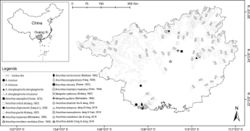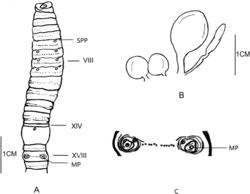Amynthas maximus
| Notice: | This page is derived from the original publication listed below, whose author(s) should always be credited. Further contributors may edit and improve the content of this page and, consequently, need to be credited as well (see page history). Any assessment of factual correctness requires a careful review of the original article as well as of subsequent contributions.
If you are uncertain whether your planned contribution is correct or not, we suggest that you use the associated discussion page instead of editing the page directly. This page should be cited as follows (rationale):
Citation formats to copy and paste
BibTeX: @article{Dong2019ZooKeys884, RIS/ Endnote: TY - JOUR Wikipedia/ Citizendium: <ref name="Dong2019ZooKeys884">{{Citation See also the citation download page at the journal. |
Ordo: Opisthopora
Familia: Megascolecidae
Genus: Amynthas
Name
Amynthas maximus Qiu & Dong sp. nov. – Wikispecies link – ZooBank link – Pensoft Profile
Material
Holotype:1 clitellate (C-GX201304-01A): China, Guangxi Zhuang Autonomous Region, Shiwan Mountain Nature Reserve ([http://ptp.pensoft.eu/redirect_to_googlemap.php?labels%5B0%5D=21.50299%C2%B0N%2C+107.3035%C2%B0E&coordinates%5B0%5D=21.50299%C2%B0N%2C+107.3035%C2%B0E 21.50299°N, 107.3035°E]), 449 m asl, black sandy soil under bryophytes in a subtropical evergreen forest, 12 May 2013, JP Qiu, Y Hong, JB Jiang, LL Zhang, Y Dong legit. Paratypes: 8 clitellates (C-GX201304-01B): same date as for holotype.
Diagnosis
Dimensions 145–170 mm by 5.8–6.2 mm at clitellum, clitellum taupe in 2/5 XIV–XVI, 78–101 segments. First dorsal pore in 13/14. Setae numbering 33–38 at III, 32–36 at V, 29–33 at VIII, 18–22 at XX, 50–65 at XXV; 9–13 between male pores; setae between spermathecal pores numbering 14–16 at VI, 10–14 at VII, and 18–22 at VIII. Four pairs of spermathecal pores ventrally in 5/6–8/9. Seven or eight (three specimens have seven papillae, and four specimens have eight papillae) postsetal genital papillae arranged in two rows in VI–IX, 0.33 circumference ventrally apart from each other. One pair of male pores in XVIII, each on the top of a central, round porophore surrounded by three or four circular ridges, with one presetal indented-topped genital papilla medial of each porophore. Ampulla elongate oval, stout duct as long as 3/5 ampulla. Diverticulum slightly shorter than main pouch, a little twist in the middle, terminal 2/5 dilated into a swollen, club-shaped seminal chamber. Prostate glands well developed.
| Characteristics | A. maximus sp. nov. | A. dorsualis | A. carnosus | A. corticis | A. wulinensis |
|---|---|---|---|---|---|
| Body length (mm) | 145–170 | 121–? | 110–340 | 45–170 | 128–174 |
| Body width (mm) | 5.8–6.2 | 2.7–? | 4.0–9.0 | 3.0–6.0 | 5.6–6.1 |
| Pigment | |||||
| dorsum | Light purple brown before clitellum, from light purple brown to brown after | Dark grey before clitellum, dark brown after | Dark brown or purple | Greenish brown | Whitish purple |
| ventrum | No pigment before clitellum, yellowish after | Light grey before VII, no pigment after | Dark brown or purple | No | Whitish gray |
| First dorsal pore | 13/14 | 13/14 | 12/13 | 10/11 or 12/13, usually at 11/12 | 11/12 |
| Clitellum locality | 2/5XIV–XVI | 1/10XIV-7/10XVI | XIV–XVI | XIV–XVI, occasionally shorter | XIV–XVI |
| Spermathecal pores | 4 pairs, in 5/6–8/9, 0.33C | 4 pairs, in 5/6–8/9, dorsally, 0.6C | 4 pairs in 5/6–8/9 or 3 pairs in 6/7–8/9, 0.33C | 4 pairs, 5/6–8/9, 0.33C | 4 pairs, 5/6–8/9, ventral, 0.29C |
| Male pores | Middle, round, surrounded by 3–4 circular ridges, 0.4C | Slightly raised, glandular, surrounded by 5–6 elliptic circular folds, 0.33C | Round or elliptic | Small, circular to transverse elliptical disc, 0.24–0.30C | Round or oval-shaped on setal line with depressed center, 2–3 circular folds, 0.24–0.28C |
| Papillae preclitellum | 7–8 post-setal indented-topped genital papillae arranged in two rows in VI–IX | Invisible | 8 papillae just overhead 8 spermathecal pores, 2 pairs preclitellar arranged on VIII and IX | Paired presetal and/or postsetal in some or all, near spermathecal pores | Absent |
| Papillae postclitellum | 2 presetal indented-topped genital papillae medial of porophore | Invisible | 2 paired presetal genital on XVIII and IX, 1 pair postsetal genital on XVIII | Present or absent, occasionally one or more near male pore | Oval-shaped, medial to male pore in each of XVII and XIX, occasionally XX |
| Prostate glands | XVII–XIX | XVI–XX | Well developed | XVII–XX, rudimentary or absent | XV–XX, racemose, follicular |
| Spermathecae | About 1.6 mm long, ampulla long-oval; duct as long as 3/5 ampulla | About 2.2 mm long, ampulla heart-shaped; duct as long as 2/5 ampulla | Ampulla oval or pear-shaped, duct equal to or slightly shorter than ampulla | Ampulla ovoid | Very short and stout stalk |
| Diverticulum | Shorter, lightly twist in middle, terminal 2/5, swollen, club-shaped seminal chamber | Shorter, terminal 1/5, ovoid plump seminal chamber | One-third to half of ampulla, slender stalk and a wider seminal chamber | Blunt ovioid, straight stalk | Oval, shining white seminal chamber, a slender and straight stalk |
| Accessory glands | 1 or 2 stalked accessory glands observed near ventral median line in VI, VII, VIII, IX | Invisible | – | Stalked, coelomic, bound down to parietes or retained within body wall | Paired in XVII and XIX, sessile, flowery |
Description
External characters: Light purple-brown pigment on pre-clitellum dorsum, no pigment on ventrum. Pigment from light purple-brown to brown on post-clitellum dorsum, light yellowish on ventrum. Clitellum taupe in 2/5 XIV–XVI. Dimensions 160 mm by 6.0 mm at clitellum, 92 segments. Prostomium ½ epilobous. First dorsal pore in 13/14. Setae numbering 36 at III, 34 at V, 31 at VIII, 20 at XX, 60 at XXV; 12 between male pores; Setae numbering 15 at VI, 12 at VII, 20 at VIII between spermathecal pores. Setae formula: AA = 1.1-1.4AB, ZZ = 1.2-2.0ZY. Clitellum annular, yellowish, in 2/5 XIV–XVI, setae not visible externally. Four pairs of spermathecal pores in 5/6–8/9, ventral, eye-like, 0.4 circumference ventrally apart from each other. Seven or eight (three specimens have seven papillae, and four specimens have eight papillae) postsetal genital papillae arranged in two rows in VI–X, 0.33 circumference ventrally apart from each other. One pair of male pores in XVIII, 0.4 circumference apart ventrally, each on the top of a central, round porophore surrounded by three or four circular ridges, with one presetal indented-topped genital papilla medial of each porophore (Figure 1A). Single female pore in XIV, ovoid.
Internal characters. Septa 5/6–7/8, 10/11–13/14 thick and muscular, 8/9–9/10 absent. Gizzard bucket-shaped, in VIII–X. Intestine enlarged distinctly from XV onwards. Intestinal caeca paired in XXVII, extending anteriorly to XXII, transition state, ventral margin smooth, four pointed saccules in dorsal margin. Four pairs of esophageal hearts in X–XIII, developed. Ovaries in XIII. Four pairs of spermathecae in VI–IX, short, approx. 1.6 mm long, ampulla elongate-oval; duct as long as 3/5 ampulla. Diverticulum slightly shorter than main pouch (ampulla and duct), a little twist in middle, terminal 2/5 dilated into a swollen, club-shaped seminal chamber (Figure 1B). One or two stalked accessory glands observed near ventral median line in VI–IX. Holandric: two pairs of testis sacs in X and XI, separated from each other, well developed. Two pairs of seminal vesicles in XI and XII, developed. Prostate glands undeveloped, inserting in XVIII and extending from XVII–XIX, coarsely lobate, prostatic duct I-shaped, of uniform thickness. No accessory glands observed in male pore region.
Etymology
The species is named after its large accessory glands observed in the spermathecal area.
Remarks
Amynthas maximus sp. nov. keys to the corticis-group in Sims and Easton (1972)[1] with four pairs of spermathecal pores intersegmentally in 5/6–8/9. Amynthas maximus sp. nov. is similar to Amynthas carnosus (Goto & Hatai, 1899) as re-described by Chang et al. (2016)[2] with respect to body size, the distance between spermathecal pores and male pores, shorter diverticulum than main spermathecal axis, and no accessary glands near prostates. In contrast, the pigment on its ventrum is lighter than A. carnosus and other differences include the first dorsal pore, clitellum location, spermathecal pores, and male pores characters. The first dorsal pore in A. maximus sp. nov. is located in 13/14, versus 12/13 in A. carnosus; the clitellum occupies less than three segments; four pairs of spermathecal pores while sometimes three pairs in A. carnosus; the porophore is surrounded by three or four circular ridges, but no ridges are present in A. carnosus; several accessory glands observed in the spermathecal region in the new species but none in A. carnosus.
We also compare the new species with Amynthas corticis (Kinberg, 1867) which has been recognized as the typical species in the corticis-group. They share several common characters such as body size, pigment, clitellum extent, setal number, and both have stalked accessory glands. Other than that, the first dorsal pore in the new species is in 13/14, but in 10/11 or 12/13, usually in 11/12 in A. corticis. The diverticulum of A. maximus sp. nov. has a small twist in the middle compared with A. corticis, which has a long stalk. Moreover, A. maximus sp. nov. always exhibits genital markings in the male pore region, whereas in A. corticis, these markings are occasionally absent.
We further compare the new species with another species Amynthas dorsualis Sun & Qiu, 2013 described from Hainan, China, and its clitellum also occupies fewer than three segments. In our results, we find the two species share several common characters, including the first dorsal pore location, setal formula, male pore characters, and in the diverticulum being shorter than the main pouch. However, the morphological dissimilarity of the two species is substantial. For instance, the locations of spermathecal pores are different between A. dorsualis and A. maximus sp. nov. In A. dorsualis, the spermathecal pores are located on the dorsum, while the pores are located on the ventrum in A. maximus sp. nov. The distance between male pore is shorter on the ventral side in A. dorsualis than Amynthas maximus sp. nov. In addition, A. dorsualis has no genital markings and no accessory glands, whereas A. maximus sp. nov. exhibits genital markings near the spermathecal pores and the male pores region, and stalked accessory glands are present in spermathecal pores region.
The body size of A. maximus sp. nov. is similar to A. wulinensis described from Taiwan Island. But the other characters of A. maximus sp. nov. differ from A. wulinensis. Amynthas maximus sp. nov. has no pigment before clitellum, yellowish after clitellum on dorsum, first dorsal pore in 13/14, 0.33C between spermathecal pores, seven or eight indented-topped genital papillae in VI–IX and accessory glands in spermathecal pores region. In contrast, A. wulinensis has whitish gray on dorsum, first dorsal pore in 11/12, 0.29C between spermathecal pores, no genital papillae observed in spermathecal pores region, and accessory glands observed in male pores region. Table 2 shows the comparison of characters of A. maximus sp. nov. with A. dorsualis, A. carnosus, A. corticis and A. wulinensis.
Original Description
- Dong, Y; Law, M; Jiang, J; Qiu, J; 2019: Three new species and one subspecies of the Amynthas corticis-group from Guangxi Zhuang Autonomous Region, China (Oligochaeta, Megascolecidae) ZooKeys, 884: 23-42. doi
Images
|
Other References
- ↑ Sims R, Easton E (1972) A numerical revision of the earthworm genus Pheretima auct. (Megascolecidae: Oligochaeta) with the recognition of new genera and an appendix on the earthworms collected by the Royal Society North Borneo Expedition.Biological Journal of the Linnean Society4: 169–268. https://doi.org/10.1111/j.1095-8312.1972.tb00694.x
- ↑ Chang C, Snyder B, Szlavecz K (2016) Asian pheretimoid earthworms in North America north of Mexico: an illustrated key to the genera Amynthas, Metaphire, Pithemera, and Polypheretima (Clitellata: Megascolecidae).Zootaxa4179(3): 495–529. https://doi.org/10.11646/zootaxa.4179.3.7

